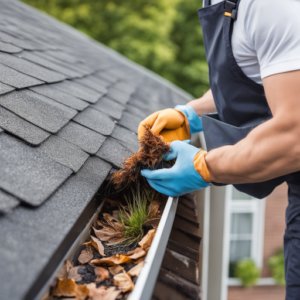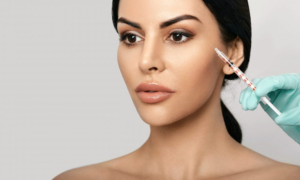Gutter cleaning removes dirt, debris, and leaves from roof gutters and downspouts. It also includes flushing and inspecting the system for damage.
A well-functioning gutter system directs rainwater away from the home’s walls, foundation, and landscaping. However, clogged gutters can lead to water overflow and damage. Regular gutter cleaning prevents these issues and keeps the system flowing properly. Contact WindowWorks LLC now!

Gutter cleaning may seem mundane, but it plays an essential protective role. When clogged, gutters redirect rainwater in ways that can damage the home’s foundation, cause basement flooding, deteriorate the roof and fascia, and encourage pest infestation. Regular maintenance is key to preventing these issues, but many homeowners fail to keep up with the task. This often leads to costly repairs, safety hazards for the home’s occupants, and other serious consequences.
The first step in gutter cleaning is removing accumulated debris. Professionals mount a ladder to access the gutters, then use high-powered blowers to ensure all nooks and crannies are clean. They work carefully, section by section, to make sure the gutter troughs are free of leaves, twigs, and dirt buildup. The blowers also direct their forceful airstream into the downspouts to clear any blockages and ensure a smooth exit for rainwater. Then, they use a garden hose to flush away any remaining debris. As they work, the professionals also check for any areas that need repair.
Debris that doesn’t get cleaned out of the gutters can become wet and rotten, which can attract pests like rodents and mosquitoes. The wet environment can also promote mold growth and other harmful health issues.
A wet, rotting gutter is also an inviting place for moss and other vegetation to grow. Eventually, these plants can break down the gutters, causing leaks in the seams and rust spots on metal gutters. Leaks can spread over time, causing even more damage and leading to an expensive repair bill.
The best way to avoid this is by keeping up with your gutter cleaning routine. When you do, look for the signs that your gutters are clogged: overflowing during rainfall, water stains or discoloration on exterior walls and siding, or the presence of mud and plant roots around the gutters. If you notice any of these issues, call a professional to schedule a clean. While a DIY gutter clean might save you money, it can be dangerous, especially when done on a ladder. Choosing a sturdy ladder that’s designed for outdoor use and following the three-points-of-contact rule of safety (two feet on the ladder, one hand on the railing, and another person below to support the ladder) is essential for safe cleaning.
Water Damage
Gutters are often out of sight and out of mind, so it’s easy to ignore them until they become clogged with debris. Clogged gutters can lead to water damage inside your home, as well as exterior damage to your roof and siding. Regular gutter cleaning can help prevent these problems and safeguard your home’s longevity.
One of the most common consequences of neglecting your gutters is water damage to your interior walls and basement. Clogged gutters force rainwater to overflow and spill against the foundation of your house, which can cause cracks over time. It can also cause soil saturation, which weakens the structural integrity of your home and leads to expensive repairs.
Another big problem of clogged gutters is mold growth. Mold spores thrive on wet surfaces, and when the spores get into your home through clogged downspouts, they can trigger respiratory issues for you and your family. To avoid this, regularly inspect your gutters for signs of mold and other damage, and be sure to clean them whenever needed.
If you’re not comfortable climbing a ladder to check your gutters, you can also look for other telltale signs that it’s time for an inspection and cleaning. For example, if your gutters are sagging or seem to be leaning, it’s a sign that they need attention. You can also look for stains on your house’s siding that indicate overflowing gutters.
You can also hire a professional to perform a thorough visual inspection of your gutters and downspouts. They’ll check for clogs, water damage, mold, and other problems that may require attention. Make sure to choose a company that is licensed, insured and bonded. Although it may cost a bit more than an unlicensed weekend warrior, hiring a reputable company can save you money in the long run by preventing costly damages to your home.
Gutters and downspouts are crucial for directing rainwater away from your home’s foundation, preventing water damage to the basement, and keeping mold, mildew, pests and rot at bay. By committing to routine gutter cleaning, you can protect your home from expensive water damage, extend the life of your gutters and roof, and improve its curb appeal.
Stains & Mildew
Stains and mildew aren’t just unsightly; they can also be a sign of gutter problems. If water sits in the gutter for an extended period of time, it can cause the growth of mildew and mold, which not only detracts from your home’s curb appeal but may also be a health hazard for your family. If left untreated, a mildew and mold problem can also lead to more serious issues such as roof leaks and rotted fascia and siding.
In addition to stains, black streaks (also called tiger striping) can also indicate that it’s time for a cleaning. These streaks are a result of oxidized black gunk, which is composed of a mix of dirt, leaves and twigs, asphalt from your shingles, and other organic materials. It is difficult to remove once it has accumulated, so regular cleanings are essential.
To get rid of stains, you can use an all-purpose cleaner or white vinegar. Vinegar is safe and effective and can help remove grime without scratching the surface of your gutters. You can use a scrub brush to remove any built-up material and then rinse the gutters with a hose. If your gutters are made of aluminum, make sure to use a soft-bristled brush that will not scratch the surface.
Another option is to use a homemade solution of one part bleach and two parts water. This will not only kill the mildew and mold but also deodorize your gutters. If you prefer to avoid bleach, you can always hire a professional gutter cleaning service.
Performing a visual inspection of your gutters is a great way to gauge how much maintenance they need. If they are sagging or appear to be bowed in the middle, it is a sign that they are overflowing during heavy rains and need to be cleaned out. You can also look for rust or other signs of structural damage. Additionally, you should check the connections of your gutter system and recheck for clogs after cleaning. A clogged gutter can become a breeding ground for pests such as mosquitoes and cockroaches, and it can cause severe water damage to your roof, siding, and foundation.
Roof Leaks
Roof leaks can cause serious structural damage to your home. If the leaking water comes into contact with the wood framing, drywall or insulation it can lead to rot and mold growth. If left unattended, the damage can spread throughout your home and require costly roof repair and replacement. Regular gutter cleaning can help to avoid these issues by ensuring that water flows freely off your roof.
Gutters are designed to direct rainwater away from the foundation of your house, but when they’re clogged, they can’t do their job properly. This can result in water spilling over the sides of your gutters and downspouts and seeping into your home. This can lead to foundation problems, basement flooding, and damp walls and ceilings.
Gutter cleaning can prevent this problem by ensuring that water flows freely off your home’s roof and into the downspouts. In addition, professional gutter cleaners can inspect your roof and gutter system for any signs of damage or wear, including rust or missing shingles, which can be repaired to prevent future leaks and water infiltration.
In colder climates, clogged gutters can also lead to the formation of ice dams. These buildups occur when melting snow refreezes near your gutters and creates a barrier that blocks the flow of water off your roof. Gutter cleaning can prevent this problem by promoting free water flow and reducing ice accumulation.
When gutters are clogged with leaves, twigs, and debris, they can’t efficiently channel rainwater away from your roof and into downspouts. This can cause overflow and pooling water that causes damage to shingle surfaces, fascia boards, and soffit materials. Over time, these problems can lead to cracks and holes in your roof that allow for water infiltration and other serious damage.
Clogged gutters can also become breeding grounds for pests like rodents, ants, and mosquitoes. Over time, these pests can spread deadly diseases and cause damage to your home. Regular gutter cleaning can eliminate pest habitats and get rid of the organic material that they thrive on. Gutter cleaning can also reduce the risk of disease-spreading plant growth, such as weeds and tree seedlings.





